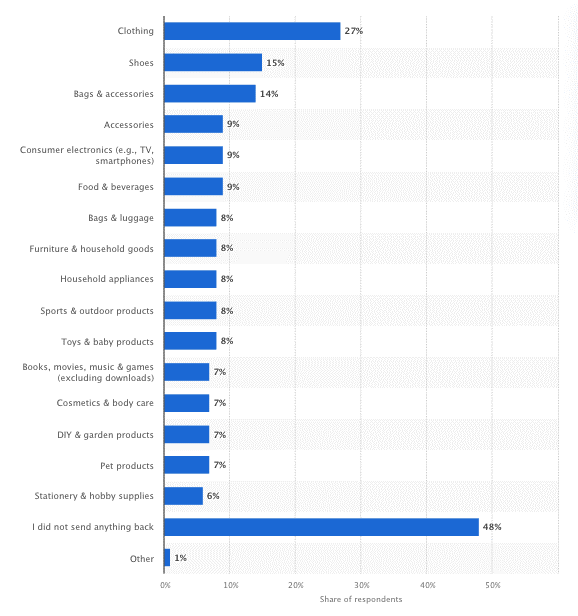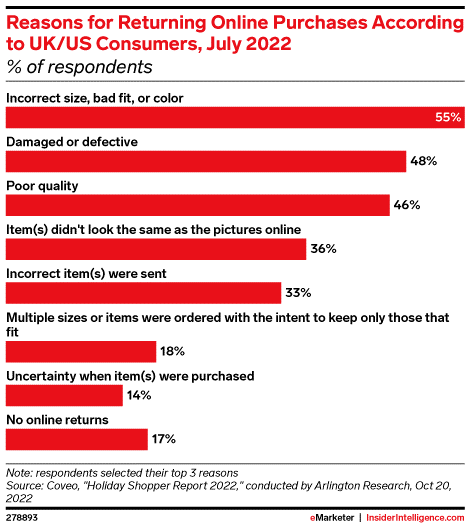Returns are inevitable when you sell products online. After all, customers are purchasing them sight unseen, without any idea of how products look, feel or fit.
But some products are returned more than others. In reality, returns are increasing overall.
In this article, we dive into the most returned items to discover what they are and why customers return them. If you run an eCommerce store and want to get on top of your returns process, this article is for you.
The current state of UK returns
Returns are becoming a big problem for online retailers, especially if they aren't prepared.
Currently, one in three items bought online are returned, compared to a 9% return rate for items bought in-store.
As the returns market grows this means costs per return for retailers increases too. A return parcel costs retailers £20 on average due to shipping, warehousing, and repackaging. In total, returns cost UK retailers £60 billion each year. This is why it is extremely important to implement an efficient and optimised returns solution to bring down costs and make returns as easy for your business as they should be for your customers.
It’s making reverse logistics a big business. The market is currently valued at over $700 billion and is expected to be worth $954.5 billion by 2029.
What are the most returned items?
So, what are the most returned items for UK retailers? According to the latest research, clothing, shoes, accessories, consumer electronics, and bags are among the most returned items.

Let’s look at each of them in more detail below.
Clothing and apparel
It won’t come as much of a surprise to retailers that clothing and other apparel are the most returned products. These are among the most subjective purchases we make and the hardest to assess when shopping online.
There are plenty of reasons shoppers might return clothing, including:
- Problems with the fit
- Because it doesn’t match the product description
- Or because consumers just don’t like the items
Unfortunately, many shoppers also purchase items intending to return them. Customers have become accustomed to treating their homes like changing rooms, ordering multiple products and sizes just to try on. This problem has become so severe that brands like ASOS and Zara have blocked tens of thousands of customers from returning too many items.
Shoes
Shoes are one of the most popular online purchases, with eCommerce sales reaching $11.6 billion in 2023. That’s over one-quarter of total fashion spend.
No wonder, they are second on the list, accounting for 15% of consumers saying they return shoes more than anything else.
Shoes are just as big a risk as clothing when it comes to buying them online. Consumers cannot know how they will fit, how comfortable they will be, or whether they like the design in person.
In fact, when the British Footwear Association surveyed consumers, it found almost one in five shoes bought online were returned. In comparison, in-store purchases had just a 5% return rate.
If it weren’t for the fact we buy more clothing than shoes, it could be number one.
Accessories
When buying accessories online, consumers face the same problems as they do clothing and apparel. Fit, comfort, and design are all issues.
Electronics
Consumer electronics are increasingly bought online and now account for one in ten returns. Like clothing, there are several reasons why consumers might return them. Non-defective products might be the biggest reason, but issues with installation and consumer preferences can also lead to returns.
Bags and luggage
Finally, we have luggage and other bags, which 10% of consumers say they return more than anything else. Again, it can be difficult to get an idea of the size and design of their luggage when buying online — or how sturdy the product is.
That’s why detailed descriptions and product videos can make such a big difference. Showing just how much you can fit in a suitcase and how well it fits into an airline’s overhead luggage compartment will not only increase purchases but also decrease returns.
What are the main reasons for returns?
So we know what customers are returning, but why are they returning them? Luckily, Coveo has the answer. According to their research into consumers in the U.S and UK, incorrect size, fit and colour is the top reason customers make returns.
Also high on the list is damaged and poor-quality products, items not looking the same as the pictures online, and consumers ordering multiple sizes with the intent to keep only the ones that fit.

Products didn’t fit or work as intended
It’s no surprise that the top reason for completing a return (chosen by 55% of all respondents) is incorrect size, poor fit, or colour.
When you can’t see or hold what you’re buying, customers will undoubtedly return at least some of the items they purchase.
Damaged, defective or poor-quality products
Damaged products are the second most common reason customers return goods, given by 48% of respondents in the Coveo survey.
The good news is that a lot of these returns can be avoided.
Damage can occur before you package the products or during transport. You can reduce returns due to damage by correctly labelling fragile parcels or by working with a logistics partner that takes care when handling your goods.
Products don’t match the description
Over one-third of customers return products because they don’t match the description or look the same as the pictures online.
Unfortunately, retailers, this one’s on you. Reduce this problem by providing detailed and accurate product descriptions as well as high-quality images.
Purchasing with the intent to return
Some shoppers are bent on returning products, even before they order them. This was an issue before the pandemic, but it’s become even more common in the wake of COVID-19. Today, 18% of customers say they order multiple sizes and only keep the items that fit best.
Returning a gift
Everyone’s received a gift they didn’t want. Some give it to the charity shop, others regift it. But a fair few people return them to the retailers, too.
In fact, The Post Office found UK consumers returned £232 million worth of Christmas gifts at the start of 2023 at an average value of £74 per gift.
Returns Fraud
There are plenty of legitimate reasons for returning a purchase, but unfortunately, there are also some fraudulent ones. Research shows that 32% of consumers have falsely claimed that an order arrived damaged or unusable, and 26% said a package that did arrive, didn’t
It’s become such a problem that some retailers are implementing AI solutions to determine the identity and intent behind each return. There are many ways that your business can spot fraudulent returns early and implement methods to mitigate the effects of returns fraud. Just check out our handy guide to returns fraud and how you can prevent it.
Do returned items differ by country?
In general, no. Returns are just as common on the continent as they are in the UK, and European consumers return the same kinds of products, too.
Want to improve your returns process? Use a returns platform
As the rate of returns increases is it now more important than ever to optimise your returns offering and get a proper returns operations solution in place. Luckily Pro Carrier is here to help with that. There are plenty of things you can do to make the way you handle returns smoother, more efficient and more profitable.
At the very top of the list is using a dedicated returns solution.
An automated software solution makes the returns process easier for everyone from your warehouse workers to your end customer. Typically, a return platform will have a customer-facing portal that lets your customers choose how they want to return your goods. First-mile carriers will then be used to transport goods to a third-party warehouse where they can be consolidated, verified, and flagged for an early refund.
Ideally, you’ll work with the same partner for both deliveries and returns so they can hold on to stock for optimised shipping.
Working with the same provider is especially important when handling cross-border returns. At Pro Carrier, for example, we offer a Duty Drawback service whereby the duties you paid on the goods are returned to you as part of the process.
For more information on how to optimise returns in the UK and abroad, speak to one of our experts today.
